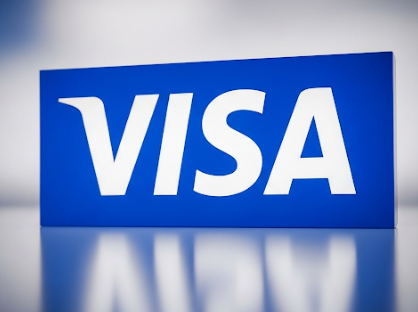1. Reasons to invest in Visa:
Visa (NYSE: V) is a dominant player in the global payments industry, and there are several compelling reasons why investors might consider its stock. Here are 5 key reasons:
Dominant Market Position and Wide Moat: Visa operates one of the largest payment networks in the world, connecting consumers, merchants, and financial institutions across more than 200 countries. This creates a powerful "network effect" where the value of its platform increases with more users and merchants, making it incredibly difficult for new competitors to enter and gain significant market share. Visa commands a significant portion of the global credit and debit card market, providing a strong competitive advantage.
Consistent Revenue and Earnings Growth: Visa consistently demonstrates strong financial performance. The company generates revenue primarily through transaction processing fees, which means it benefits directly from increased digital payment adoption and consumer spending. Even amidst economic uncertainties, Visa has shown resilient growth in payments volume, cross-border transactions, and processed transactions, leading to solid revenue and earnings per share increases. Their Q3 2025 results, for example, showed a 14% year-over-year revenue increase and a 23% rise in adjusted EPS.
High-Margin Business Model: Visa's business model is inherently high-margin. Once its global payment network is established, the cost of processing additional transactions is relatively low. This leads to impressive gross profit margins (often around 80%) and strong net profit margins, typically in the high 40s to low 50s. This profitability allows Visa to generate substantial free cash flow, which can be used for further investment, acquisitions, or returning capital to shareholders.
Long-Term Growth Potential in Digital Payments: The global shift from cash and checks to digital payment methods continues to be a major tailwind for Visa. As e-commerce expands and more economies digitize, Visa is well-positioned to capture a significant portion of this growth. The company is actively investing in and exploring new technologies like AI, stablecoins, and blockchain to maintain its relevance and expand into new payment flows and value-added services, such as real-time payments (Visa Direct) and business-to-business solutions (Visa B2B Connect).
Shareholder Returns (Dividends and Buybacks): Visa has a history of returning capital to shareholders through both dividends and share repurchases. The company has consistently increased its dividend for many years (recently for the 16th consecutive year), demonstrating its commitment to shareholder value. Additionally, share buyback programs reduce the number of outstanding shares, which can boost earnings per share and support stock price appreciation.
2. Valuations:
Visa Inc’s share price is $351.29. Its GF Value is $320.57. Based on the relationship between the current stock price and the GF Value, GuruFocus believes Visa Inc stock is Fairly Valued.
3. Moat Ranking:
I can confidently say that Visa possesses one of the strongest and most durable moats in the financial services industry. It's a textbook example of a company with deeply entrenched competitive advantages.
Moat Ranking: 9.5/10
Visa's moat is exceptionally wide and robust, bordering on impenetrable in many aspects. The sheer scale, complexity, and interconnectedness of its global network create a formidable barrier to entry and give it immense pricing power. The only reason it's not a perfect 10 is the ever-present, albeit currently minor, threat of disruptive technologies (like blockchain-based payments) or increased regulatory scrutiny on interchange fees that could potentially chip away at its dominance in the very long term. However, Visa is actively investing in and adapting to these changes, further solidifying its position.
Let's break down the different parts of Visa's moat:
1) Brand Loyalty and Pricing Power
Brand Loyalty: For consumers, "Visa" is synonymous with easy, secure, and widely accepted payments. While they might not be "loyal" to Visa in the same way they are to a consumer product brand, they trust the Visa logo. It signifies global acceptance and reliability. This trust is built over decades and is incredibly difficult to replicate. Merchants, on the other hand, are "loyal" in the sense that they must accept Visa if they want to participate in the vast majority of digital transactions.
Pricing Power: Visa possesses significant pricing power. Due to its essential role in the payments ecosystem, both financial institutions (issuers and acquirers) and merchants largely have to accept Visa's fees. While there's constant pressure and some regulatory efforts to reduce interchange fees, Visa (along with Mastercard) has historically been able to adjust fees and maintain profitability. The Department of Justice lawsuit against Visa for alleged monopolization in debit markets highlights this very point – that Visa can "extract fees that far exceed what it could charge in a competitive market."
2) High Barriers to Entry
Massive Capital Investment: Building a global payment network like VisaNet requires astronomical capital investment in technology infrastructure, data centers, security systems, and telecommunications. Estimates for replacing such infrastructure can run into the tens of billions of dollars.
Regulatory Hurdles & Relationships: Navigating the complex web of financial regulations across over 200 countries is a monumental task. Visa has spent decades building relationships with central banks, financial institutions, and governments worldwide, establishing trust and compliance. A new entrant would face an incredibly steep and lengthy uphill battle to gain the necessary licenses and approvals in all these jurisdictions.
Trust and Security: Payments are inherently about trust. Visa has invested billions in fraud detection and security, processing vast amounts of data to protect transactions. Building a new network with comparable levels of security and consumer/merchant trust is an enormous undertaking.
3) High Consumer Switching Costs
For Consumers: While a consumer might switch from a Visa credit card to a Mastercard credit card relatively easily, the underlying payment network itself (VisaNet) has very high switching costs for the ecosystem as a whole. Consumers generally don't choose between "Visa network" and "another network" when making a purchase; they choose a card that runs on one of the major networks. The ease of use and ubiquity of Visa cards mean there's little incentive for a consumer to actively seek out alternatives for their everyday transactions. The implicit cost of not being able to use their preferred payment method at millions of merchants worldwide is very high.
For Merchants: For a merchant, not accepting Visa means potentially losing out on a significant portion of their sales, as Visa cards are so widely held. The cost of setting up alternative payment acceptance systems and potentially losing customers who prefer to pay with Visa is a huge deterrent.
For Banks: Banks are deeply integrated into the Visa network. The operational and technical costs of migrating their card portfolios and processing systems to a different network would be immense, not to mention the potential disruption to their customers.
4) Network Effect
Two-Sided Network: Visa is the quintessential example of a powerful two-sided network effect.
More Cardholders More Merchants: The more consumers who carry Visa cards, the more attractive it is for merchants to accept Visa, as it provides access to a larger customer base.
More Merchants More Cardholders: Conversely, the more merchants that accept Visa, the more valuable and convenient it is for consumers to have a Visa card.
Self-Reinforcing Cycle: This creates a virtuous cycle. As the network grows, its value to all participants increases, leading to further adoption and reinforcing its dominance. Visa's scale (billions of credentials, millions of merchant locations, trillions of transactions annually) makes its network effect virtually unassailable.
5) Economies of Scale that Give a Cost Advantage
Spreading Fixed Costs: Visa's massive transaction volume allows it to spread its enormous fixed costs (infrastructure, technology, security, R&D) over a vast number of transactions. This leads to extremely low per-transaction costs, giving Visa a significant cost advantage over any potential smaller competitor.
Efficiency and Automation: The company's highly automated and sophisticated processing systems enable it to handle immense transaction volumes with exceptional efficiency, further lowering its operating costs relative to revenue.
Data Advantage: The sheer volume of data Visa processes provides it with unparalleled insights into consumer spending patterns and fraud trends. This data can be leveraged to develop new services, improve security, and optimize its network, giving it a further competitive edge.
In conclusion, Visa's moat is incredibly wide, built on a foundation of a powerful network effect, high barriers to entry, substantial switching costs, and significant economies of scale. Its strong brand, coupled with its ability to exert pricing power, makes it a highly defensible business.
4. Financial Health
Observations from the Income Statement:
Gross Profit: Shows a consistent upward trend, indicating strong revenue growth.
Operating Profit/Loss: Also demonstrates healthy growth, suggesting efficient management of operating expenses relative to revenue.
Net Income and Diluted EPS: Both metrics have steadily increased, reflecting Visa's profitability and increasing earnings per share for its common stockholders.
Total Dividend Per Share: Visa has consistently increased its dividend payout over the years, which is often a positive sign for investors.
Overall Assessment of Financial Strength:
Visa's financial strength in 2025 remains excellent.
Strong Growth: Double-digit revenue and EPS growth demonstrate the company's continued ability to capitalize on the secular trend of digital payments, both domestically and internationally.
Exceptional Profitability: The very high gross and net profit margins, coupled with a strong return on equity, underscore Visa's incredibly efficient and profitable business model. This efficiency is a direct result of its wide moat and economies of scale.
Solid Liquidity and Capital Structure: While the current ratio is not exceptionally high, it's sufficient for an asset-light company like Visa, which generates substantial free cash flow. The company's balance sheet is robust, and its commitment to share repurchases signifies confidence in its future earnings and efficient capital allocation.
Resilience: Even amidst macroeconomic uncertainties, Visa's business drivers (payments volume, cross-border volume, processed transactions) have remained strong, indicating the resilience of its services to economic fluctuations.
In essence, Visa's 2025 financial performance and ratios paint a picture of a financially sound company that is effectively leveraging its dominant market position and robust moat to deliver consistent growth and high profitability.























![[LATEST] KLSE Stock Best Dividend (UPDATED 20 MARCH 2020)](https://blogger.googleusercontent.com/img/b/R29vZ2xl/AVvXsEhIp9Zu5l7EnNju0NvAY1yq7sCgFxhkqLTWGm5c_VY6xR3lKTvKcrqp2Avp7w1lFaKtiviEMnxAftmDktmnbAck2yGX_-dI6z0vzp2-cpqKBS7ze48FxutAetF-2827pMDZtbU4RfJqfdBv/w100/TOP+27+KLSE+STOCKS.001.jpeg)
![[Covid-19 Latest Updates] KLSE Index Rebounded](https://blogger.googleusercontent.com/img/b/R29vZ2xl/AVvXsEi9SW_IBop_jhHwXL7QJBOoxDzMj9flvvsz7_OIbjPTeC6NFke0kJxhUDuxc61hiieDJJ6Gx2P0AFJwqccM6xpszFoM0wPlXnyiCJrDHhSE1vfn3aI_Agfin-p9qOwuCEyasi-wprjSqYDw/w100/Slide2.PNG)
![[LATEST] KLSE Best Dividend Stock (UPDATED 24 JANUARY 2021)](https://blogger.googleusercontent.com/img/b/R29vZ2xl/AVvXsEildh9exPtPC6TbJ5rkyBt0g8EXhogZN2XkfGpVFt4u-j0Hy_zc70JGjbYeVymxcWPZGqsneAugrZMsfd_WWwMsyyzdgY3eSdwy_AbBKGjSx0wduKVEsiXQM3Mj43XvO8l6YpmFvk9KnOfD/w100/Malaysia+Investment_KLSE+Best+Dividend+Yield+Stock_2021.png)

0 Comments
What do you think of the post?
Kindly share your input, we want to hear from you.